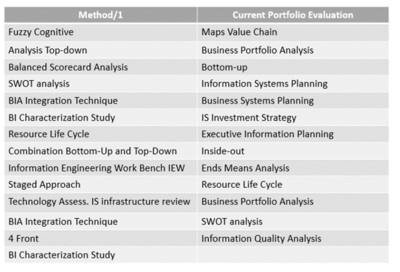Strategic Information Systems Planning (SISP)
Strategic Information Systems Planning or SISP at the most basic can be defined as “the process of determining an organization’s portfolio of computer-based applications that will help it achieve its business objectives.” (Newkirk & Lederer, 2007, p. 34).
The definition of strategic information system planning has many variations. For example Lederer and Sethi (1988) state that “(SISP) is the process of deciding the objectives for organizational computing and identifying potential computer application which the organization should implement” (p.445). Hevner, Bernt, and Studnicki (2000) state that “(SISP) is the process of aligning an organization’s business strategy with effective computer-based information systems to achieve critical business objectives” (p. 1). Doherty et al. (1999) offer a composite definition from different sources and state that SISP is “the process of identifying a portfolio of computer-based applications to be implemented, which is both highly aligned with corporate strategy and has the ability to create an advantage over competitors” (p. 265). Each of these definitions states that there is a process to strategic information system planning.
SISP is needed in order to align IT with the strategic goals of an organization in order to identify new opportunities, and that organizations miss opportunities and fail to implement new business strategies without SISP (Kearns, 2006, p. 237; Lederer & Sethi, 1988, p. 445). The general consensus is that:
(a) there is an ongoing need for strategic information systems planning (Henderson & Sifonis, 1988), and
(b) that SISP has a direct impact in an organizations ability to execute its strategic business strategy, maximize its performance, and leverage IT investments for competitive advantage (Johnson & Lederer, 2010).
What SISP is Not[1]
- SISP is unlikely to lead to fundamental changes in strategy. Situations rarely call for dramatic shifts in course. SISP should not lead to change for the sake of change, nor is it a rubber-stamp for current directions, past actions, or preconceived notions of how things should be.
- SISP is not the final written document, a detailed implementation plan, or a budgeting exercise. It is a learning process that should result in an improved, shared vision of the IS/IT function among senior managers and identification of a select group of potential business initiatives which, after further review, may afford opportunities for high returns on investment.
- SISP is not something that can be contracted out to external consultants. The strategic plan must be “owned” by agency executives, critical stakeholders, senior agency managers, and senior IT staff. A consultant’s report can be (and often is) rejected by agency executives and critical stakeholders. Although consultants may provide useful assistance at various points in the planning process, extreme care must be exercised lest the result be theirs and not yours.
- SISP is not a technical exercise to create a unified data architecture or extensive, explicit models of all of the agency’s business processes (at least not as the term is used here). Although such long-term, time, and resource intensive ventures may be worthwhile, they are not a part of the SISP process described here.
SISP Methodologies[2]
There are a number of SISP methodologies to choose from. Pita et al. (2008) provide a list of a number of SISP methodologies, which is reproduced in the Table below. While this list is by no means exhaustive, it shows the range of methodologies and provide a means for those interested in further study. An attempt to determine the most used methodology does not yield definitive results; however, Pita et al. (2008) list the top methodologies used in Australia and suggest that the most popular methodologies are alignment methodologies (p. 754).
Strategic information systems planning is considered a complex activity with a potential for problems, thus it’s important for the organization to choose the methodology with the best fit (Lederer & Sethi, 1988, p. 448). As noted by Lederer and Sethi (1988) organizations may choose to adopt a specific SISP methodology or modify an existing strategic management planning strategy and incorporate information technology (p. 448). An organization may also choose to combine a number of SISP methodologies into a SISP approach (Doherty et al., 1999, p. 265). According to Pita et al. (2008), “one of the major issues on the IS planning agenda is choosing the right methodology” and that the use of more than one methodology is preferred (p. 752). Additionally, Pita et al. (2008) note that the selection of a wrong SISP methodology can significantly contribute to SISP failure (p. 752).
- ↑ What SISP is Not Michael Lombardo et al.
- ↑ SISP Methodologies Brian Fergerson

